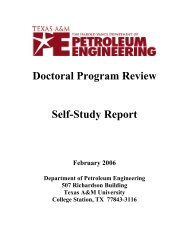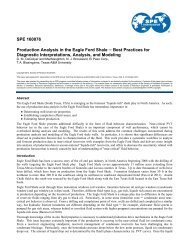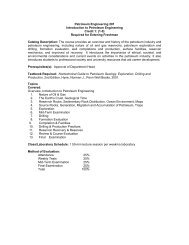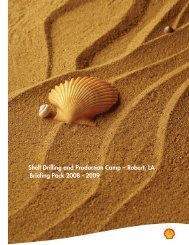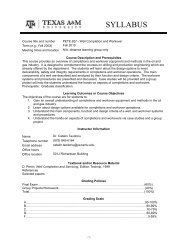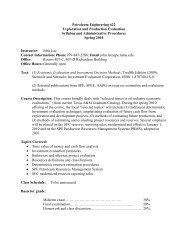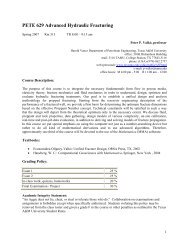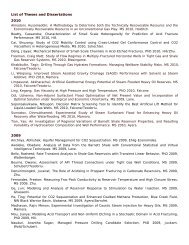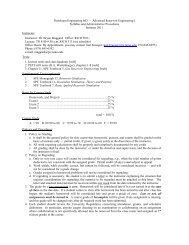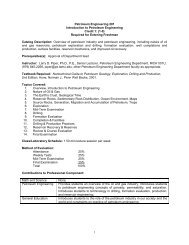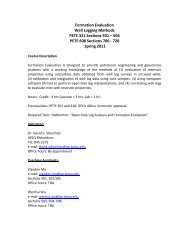Crisman Annual Report 2009 - Harold Vance Department of ...
Crisman Annual Report 2009 - Harold Vance Department of ...
Crisman Annual Report 2009 - Harold Vance Department of ...
Create successful ePaper yourself
Turn your PDF publications into a flip-book with our unique Google optimized e-Paper software.
Alternate Power and Energy Storage/Reuse for Drilling Rigs: Reduced Cost and<br />
Lower Emissions Provide Lower Footprint for Drilling Operations<br />
Introduction<br />
Diesel engines operating the rig pose the problems<br />
<strong>of</strong> low efficiency and large amount <strong>of</strong> emissions. In<br />
addition the rig power requirements vary a lot with<br />
time and ongoing operation. Therefore it is in the<br />
best interest <strong>of</strong> operators to research on alternate<br />
drilling energy sources which can make entire drilling<br />
process economic and environmentally friendly. One<br />
<strong>of</strong> the major ways to reduce the footprint <strong>of</strong> drilling<br />
operations is to provide more efficient power sources<br />
for drilling operations. There are various sources<br />
<strong>of</strong> alternate energy storage/reuse. A quantitative<br />
comparison <strong>of</strong> physical size and economics shows<br />
that rigs powered by the electrical grid can provide<br />
lower cost operations, emit fewer emissions, are<br />
quieter, and have a smaller surface footprint than<br />
conventional diesel powered drilling.<br />
with significantly lower emissions, quieter operation,<br />
and smaller size well pad.<br />
Objectives<br />
This project describes a study to evaluate the<br />
feasibility <strong>of</strong> adopting technology to reduce the size<br />
<strong>of</strong> the power generating equipment on drilling rigs<br />
and to provide “peak shaving” energy through the<br />
new energy generating and energy storage devices<br />
such as flywheels.<br />
Approach<br />
An energy audit was conducted on a new generation<br />
light weight Huisman LOC 250 rig drilling in South<br />
Texas to gather comprehensive time stamped<br />
drilling data. A study <strong>of</strong> emissions during drilling<br />
operation was also conducted during the audit. The<br />
data was analyzed using MATLAB and compared to a<br />
theoretical energy audit.<br />
Accomplishments<br />
The study showed that it is possible to remove<br />
peaks <strong>of</strong> rig power requirement by a flywheel<br />
kinetic energy recovery and storage (KERS) system<br />
and that linking to the electrical grid would supply<br />
sufficient power to operate the rig normally. Both<br />
the link to the grid and the KERS system would fit<br />
within a standard ISO container.<br />
Significance<br />
A cost benefit analysis <strong>of</strong> the containerized system<br />
to transfer grid power to a rig, coupled with the KERS<br />
indicated that such a design had the potential to save<br />
more than $10,000 per week <strong>of</strong> drilling operations<br />
Project Information<br />
2.1.5 Rig Energy Efficiency Study<br />
Related Publications<br />
Verma, A.: <strong>2009</strong>. Alternate Power and Energy Storage/<br />
Reuse for Drilling Rigs: Reduced Cost and Lower Emissions<br />
Provide Lower Footprint for Drilling Operations. MS thesis.<br />
Texas A&M U., College Station, Texas.<br />
Contacts<br />
David Burnett<br />
979.845.2274<br />
david.burnett@pe.tamu.edu<br />
Ankit Verma<br />
CRISMAN INSTITUTE<br />
48<br />
<strong>Crisman</strong> <strong>Annual</strong> <strong>Report</strong> <strong>2009</strong>



